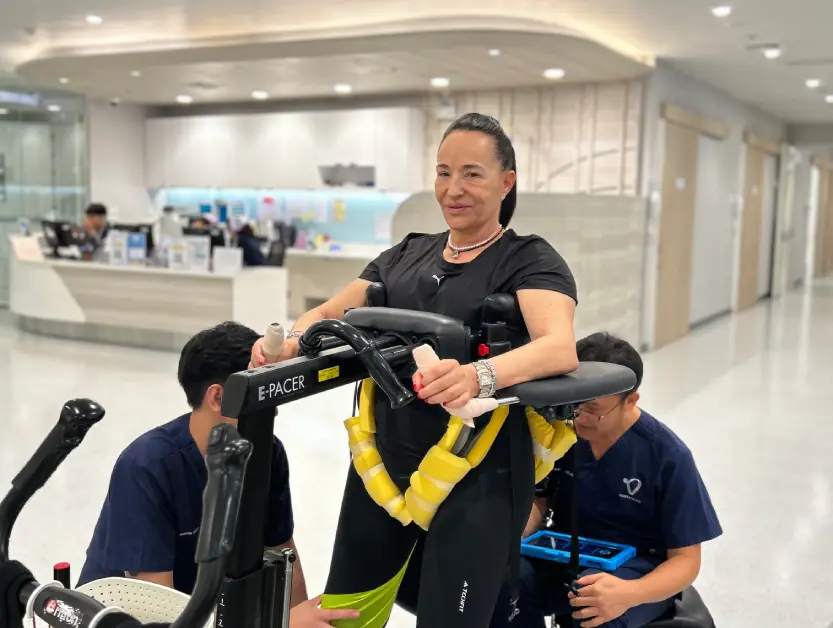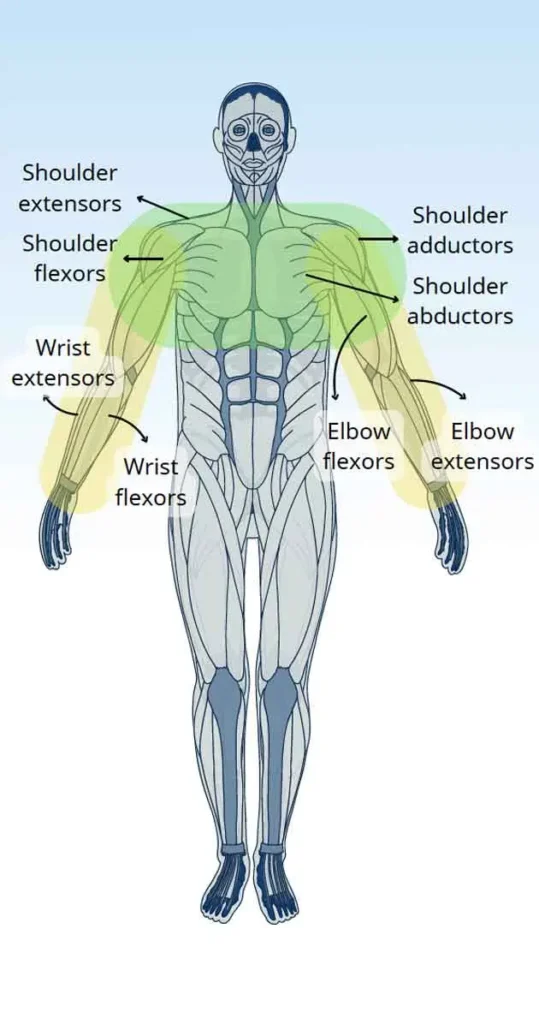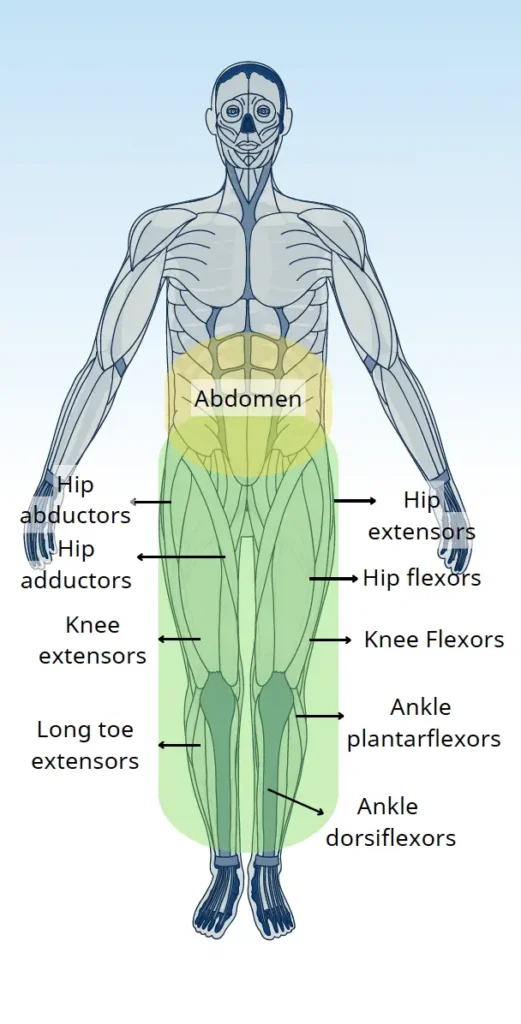Karen
- Spinal Cord Injury (SCI),
- C4, C5, Complete
Epidural Stimulation

| Treatment received | Implantation site | Number of devices | Duration of stay |
|---|---|---|---|
| Epidural Stimulation | Cervical spinal cord | 1 | 50 days |
| Epidural Stimulation | Lumbar spinal cord | 1 | 50 days |
| Post-surgical care | Total sessions | Sessions per week | Time (Hr.) per session |
|---|---|---|---|
| Physical Therapy & Lower Extremity Mapping | 106 | 17 | 1 |
| Occupational Therapy & Upper Extremity Mapping | 84 | 12 | 1 |
| Total Sessions of Rehabilitation | 190 |

| Muscle improvement | Before Epidural Stimulation surgery | At discharge (50 days after admission) | 1st remapping (1 year after discharge) | 2nd remapping (2 year after discharge) |
|---|---|---|---|---|
| Shoulder flexors | 3 | 3+ | 4 | 4 |
| Shoulder extensors | 3 | 3+ | 4 | 4 |
| Shoulder abductors | 3 | 3+ | 4 | 5 |
| Shoulder horizontal abductors | 3 | 3+ | 4 | 4 |
| Shoulder adductors | 3 | 4 | 4 | 4 |
| Shoulder horizontal adductors | 1 | 2 | 2+ | 2+ |
| Elbow flexors | 4 | 4 | 5 | 5 |
| Elbow extensors | 1 | 1+ | 2 | 3 |
| Wrist flexors | 1 | 1 | 1+ | 1+ |
| Wrist extensors | 2 | 3 | 3 | 3 |
| Finger flexors | 1 | 2 | 3 | 3 |
| Finger extensors | 1 | 2 | 2 | 2 |

| Muscle improvement | Before Epidural Stimulation surgery | At discharge (50 days after admission) | 1st remapping (1 year after discharge) | 2nd remapping (2 year after discharge) |
|---|---|---|---|---|
| Hip flexors | 0 | 2 | 2 | 2 |
| Hip extensors | 0 | 1 | 2 | 2 |
| Hip abductors | 0 | 1 | 1 | 1 |
| Hip adductors | 0 | 1 | 2 | 2 |
| Knee extensors | 0 | 1 | 2 | 3 |
| Knee flexors | 0 | 1 | 1 | 2 |
| Ankle dorsiflexors | 0 | 2 | 2 | 2 |
| Ankle plantarflexors | 0 | 1 | 1 | 2 |
| Long toe extensors | 0 | 1 | 1 | 1 |
| Abilities & Symptoms | Before Epidural Stimulation surgery | At discharge (50 days after admission) | 1st remapping (1 year after discharge) | 2nd remapping (2 years after discharge) |
|---|---|---|---|---|
| Feeding | Supervision (using strap) | Improved (grasp and hold spoon with large holder) | Improved (more natural pattern) | No change |
| Grooming (personal hygienic care) | Supervision (using strap) | Improved (grasp and hold spoon with large holder) | No change | No change |
| Dressing | Assistance required | Improved | Improved | Improved |
| Writing | Not possible | Improved (light-large holder pen) | No change | No change |
| Grasping | Not possible | Improved (light object) | Improved (hold firmly) | No change |
| Wheelchair control (head controlled wheelchair) | Supervision (low endurance) | Improved (short distance) | Independent (outdoor controlled) | No change |
| Standing with support | Absent * | Poor * | No change | Fair * |
| Stepping with support | Absent * | Poor * | No change | Fair * |
| Standing balance | Absent * | Poor * | No change | Poor to fair * |
| Sitting balance | Poor * | Poor to fair * | No change | Fair * |
| Motor coordination (while walking) | Absent * | Poor to fair * | No change | Fair * |
| Sit to stand (in walker) | Absent * | No change | No change | No change |
| Ability to transfer | Dependent | No change | Minimum assistance | No change |
| Ability to use abdominal muscles during bowel program | Dependent | Dependent (easier with program on) | No change | No change |
| Stamina & Fatigue | Poor * | Increase endurance | Increase endurance | Increase endurance |
| Spasticity | Moderate | Mild (with program on) | No change | No change |
| Abilities & Symptoms | Before Epidural Stimulation surgery | At discharge (50 days after admission) | 1st remapping (1 year after discharge) | 2nd remapping (2 years after discharge) |
|---|---|---|---|---|
| Neuropathic Pain | Absent * | No change | No change | Increase |
| Temperature Sensations | Absent * | No change | No change | No change |
| Proprioception | Absent * | No change | No change | Increase |
| Bladder Sensation | Absent * | No change | No change | No change |
| Bowel Sensation | Absent * | No change | No change | No change |
| Abilities & Symptoms | Before Epidural Stimulation surgery | At discharge (50 days after admission) | 1st remapping (1 year after discharge) | 2nd remapping (2 years after discharge) |
|---|---|---|---|---|
| Sweating Ability | Absent * | No change | No change | No change |
| Temperature Regulation | Normal * | Normal * | Normal * | Normal * |
| Blood Pressure Regulation | Unstable | Stable | Stable | Stable |
The motor areas were significantly improved including her biceps, triceps, her ability to lock the elbow and stay in upright position in the parallel bars. Her fine and gross motor skills in upper limbs improved. She also regained muscle movements in lower limbs and was able to stand and walk with support.
Mild improvements were reported in her sensory function and proprioception.
Her blood pressure and body temperature regulation saw moderate improvements compared to before the treatment.
Her sitting balance improved significantly, she was able to sit for extended periods of time with minimal assistance.
Karen’s standing function saw major improvements. She was able to lock the left knee while standing.
Karen sustained a traumatic spinal cord injury at the C4 level resulting in a severe injury. This rendered her paralyzed from the neck down with minimal upper limbs and no function in lower limbs. She received standard physiotherapy until she travelled to Verita Neuro in Thailand for further treatment.
Upon arrival she received extensive check ups and MRI scans and was deemed a suitable candidate for both upper and lower body Epidural stimulation surgeries. She went ahead with the surgery which went well without any complications and there was normal recovery of the surgical wounds. After a 2 days break we started the mapping process and we were able to see strong muscle contractions in the corresponding muscle groups. Her motor functions gradually started to return as well as her muscle mass, strength, and stamina.
Overall, Karen reported moderate to significant improvements in her motor areas and mild improvements in her sensory functions. She reported improvements in her upper limbs and lower limbs and regained the ability to stand and walk with upper body support. Her autonomic functions improved moderately as well as her sitting balance. She also reported marked improvements in her muscle mass and strength, and overall, her quality of life was improved.
We use cookies on our website to give you the most relevant experience by remembering your preferences and repeat visits. By clicking “Accept All”, you consent to the use of ALL the cookies. However, you may visit "Cookie Settings" to provide a controlled consent.